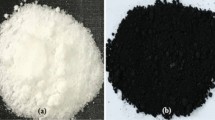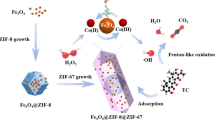Abstract
A new nano-composite energetic material, in which submicrometer ammonium perchlorate (AP) particles and nanoparticles of cyclotrimethylene trinitramine (RDX) were uniformly dispersed in the cross-linked nitrocellulose (NC), was prepared by the sol–gel method. The structure of the material was confirmed by means of SEM, XRD and N2 adsorption isotherm techniques, and the results showed that the NC/RDX/AP nano-composite energetic material is monolithic with numerous pores of nanometer scale and the mean grain size of RDX is <100 nm. The properties of the material were studied by TG/DSC and oxygen bomb calorimetry. TG/DSC analyses indicated that firstly RDX decomposed along with NC matrix and the DSC exothermic peak temperature of NC matrix and RDX is 10 °C lower than that of the physical mixture and secondly the exothermic peak temperature of AP component shifts from the lower temperature of NC matrix and RDX decomposition to the higher temperature of AP decomposition as the AP mass ratio increases. The heat-of-explosion tests showed that the NC/RDX/AP nano-composite energetic materials produced more energy during explosion and the sensitivity of them is lower than that of the physical mixture according to the impact sensitivity test.
Graphical abstract
A new nano-composite energetic material, in which submicrometer ammonium perchlorate (AP) particles and nanoparticles of cyclotrimethylene trinitramine (RDX) were uniformly dispersed in the cross-linked nitrocellulose (NC), was prepared by the sol–gel method.










Similar content being viewed by others
References
Cudziło S, Kiciński W (2009) Preparation and characterization of energetic nanocomposites of organic gel–inorganic oxidizers. Propellants Explos Pyrotech 34:155–160
Teipel U (ed) (2005) Energetic materials—particle processing and characterization. Wiley-VCH, Weinheim
Pivkina A, Ulyanova P, Frolov Y et al (2004) Nanomaterials for heterogeneous combustion. Propellants Explos Pyrotech 29:39–48
Tillotson TM, Gash AE, Simpson RL et al (2001) Nanostructured energetic materials using sol–gel methodologies. J Non-Cryst Solids 285:338–345
Song X, Wang Y, An C et al (2008) Dependence of particle morphology and size on the mechanical sensitivity and thermal stability of octahydro-1, 3, 5, 7-tetranitro-1, 3, 5, 7-tetrazocine. J Hazard Mater 159:222–229
Qiu H, Stepanov V, Di Stasio AR et al (2011) RDX-based nanocomposite microparticles for significantly reduced shock sensitivity. J Hazard Mater 185:489–493
Li J, Brill TB (2006) Nanostructured energetic composites of CL-20 and binders synthesized by sol gel methods. Propellants Explos Pyrotech 31:61–69
Tappan BC, Brill TB (2003) Thermal decomposition of energetic materials 86. Cryogel synthesis of nanocrystalline CL-20 coated with cured nitrocellulose. Propellants Explos Pyrotech 28:223–230
Tillotson TM, Hrubesh LW, Simpson RL et al (1998) Sol–gel processing of energetic materials. J Non-Cryst Solids 225:358–363
Gash AE, Simpson RL, Satcher JH (2003) Nanostructured energetic materials with sol–gel chemistry, LLNL, 201119
Chen X, Song G, Sun J (2012) Preparation of HMX–AP–SiO2 nano-composite energetic materials by sol–gel method. China Powder Sci Technol 18:47–54
Nie F, Zhang J, Guo Q et al (2010) Sol–gel synthesis of nanocomposite crystalline HMX/AP coated by resorcinol–formaldehyde. J Phys Chem Solids 71:109–113
Jin M, Luo Y (2012) Preparation and characterization of RF/AP nano-composite energetic materials. Chin J Explos Propellants 35:65–69
Tappan BC, Brill TB (2003) Thermal decomposition of energetic materials 85: cryogels of nanoscale hydrazinium diperchlorate in resorcinol–formaldehyde. Propellants Explos Pyrotech 28:72–76
Chen R, Luo Y, Sun J et al (2012) Preparation and properties of an AP/RDX/SiO2 nanocomposite energetic material by the sol–gel method. Propellants Explos Pyrotech 37:422–426
Leventis N, Chandrasekaran N, Sadekar AG (2009) One-pot synthesis of interpenetrating inorganic/organic networks of CuO/resorcinol–formaldehyde aerogels: nanostructured energetic materials. J Am Chem Soc 131:4576–4577
Wang X, Li J, Luo Y et al (2014) A novel ammonium perchlorate/graphene aerogel nanostructured energetic composite: preparation and thermal decomposition. Sci Adv Mater 6:530–537
Jin M, Luo Y (2013) Preparation and characterization of nitrocellulose aerogel. Chin J Explos Propellants 36:82–86
Jin M, Luo Y (2014) Preparation and thermal properties of NC/RDX nano-composite energetic materials. Acta Armamentarii 35:822–827
Gash AE, Satcher JH, Simpson RL et al (2003) Nanostructured energetic materials with sol–gel methods. MRS proceedings, Cambridge University Press, 800, AA2, 2
Pan X (2002) Computer deduction for the relation expression of heat of detonation with formulation for mixed explosive. Min Res Dev 22(4):53–56
Liu P, Yi M, Xu X et al (1997) Verification regulation of impact sensitivity apparatus for propellants and explosives, GJB = J 3052-97. China’s National Defense Science Technology and Industry Committee
Baroody E, Peters S (1990) Heats of explosion, detonation and reaction products: their estimation and relation to the first law of thermodynamics, Johns Hopkins Univ, The 1990 JANNAF propulsion meeting
Rice BM, Hare JJ (2002) A quantum mechanical investigation of the relation between impact sensitivity and the charge distribution in energetic molecules. J Phys Chem A 106:1770–1783
Author information
Authors and Affiliations
Corresponding author
Rights and permissions
About this article
Cite this article
Jin, M., Wang, G., Deng, J. et al. Preparation and properties of NC/RDX/AP nano-composite energetic materials by the sol–gel method. J Sol-Gel Sci Technol 76, 58–65 (2015). https://doi.org/10.1007/s10971-015-3750-0
Received:
Accepted:
Published:
Issue Date:
DOI: https://doi.org/10.1007/s10971-015-3750-0




